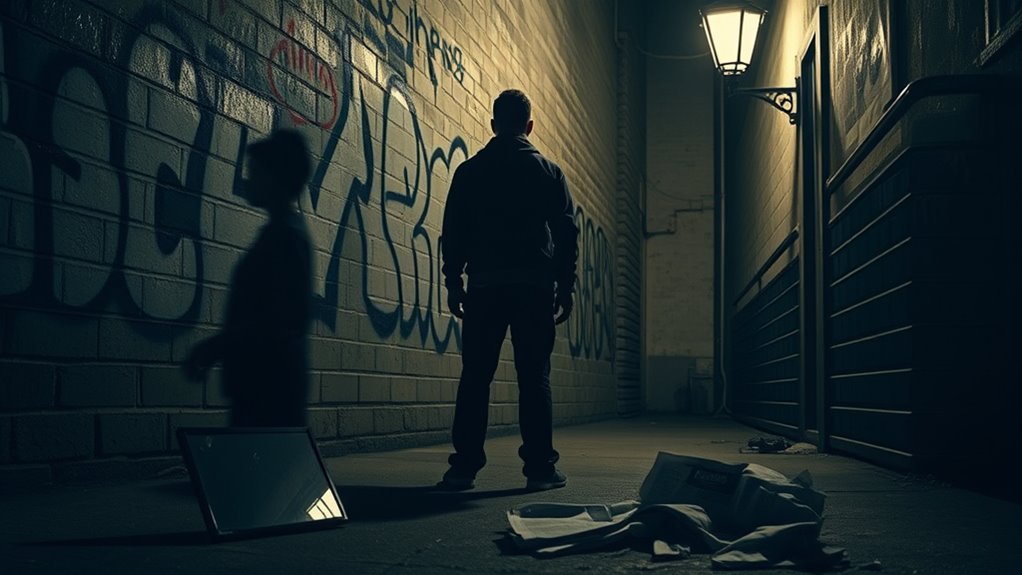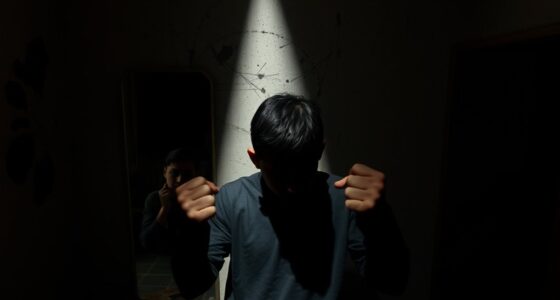Scapegoating’s all about assigning blame to maintain power and strengthen your group’s identity. By targeting outsiders, you deflect responsibility and rally support, creating a false sense of unity. This tactic can foster social cohesion but often harms marginalized communities, deepening discrimination and division. It also shapes narratives in politics and media, amplifying fears and misconceptions. Understanding this dynamic reveals how blame operates in society and highlights broader consequences you might find surprising.
Key Takeaways
- Scapegoating enables leaders to deflect blame from themselves, consolidating power by uniting followers against a common enemy.
- Media amplifies scapegoating narratives, shaping public perception and fostering divisions that benefit those in power.
- Assigning blame to marginalized groups distracts from systemic issues, allowing powerful entities to avoid accountability.
- Group dynamics encourage scapegoating to reinforce social identity, creating cohesion while diverting attention from internal problems.
- Consequences of scapegoating include increased discrimination and societal divisions, ultimately undermining trust and social progress.
The Historical Context of Scapegoating

Throughout history, societies have often turned to scapegoating as a way to deflect blame and simplify complex problems. You can see this in various cultures, where individuals or groups are unfairly targeted to divert attention from societal issues. In many cases, religious rituals played a critical role; ancient rituals often involved casting out a goat or another animal, symbolically transferring the community’s sins onto it. This practice not only provided a sense of relief but also reinforced social cohesion by uniting members against a common enemy. By understanding these ancient rituals, you can grasp how deeply rooted the concept of scapegoating is in human behavior, serving as a mechanism to maintain order amidst chaos and uncertainty. Additionally, the idea of social cohesion continues to be relevant today, as communities seek to unify against perceived threats. In modern contexts, this can be seen in various sectors, including the cruise industry, where companies may shift blame for operational challenges to external factors rather than internal shortcomings. Moreover, events like hackathons can serve as a platform for collaborative problem-solving, reducing the likelihood of scapegoating by fostering shared responsibility and innovation. Furthermore, the need for open communication during difficult times can help mitigate the tendency to scapegoat by fostering understanding and empathy among individuals. Prophetic dreams, often viewed as a form of divine communication, can also guide individuals in seeking personal accountability rather than projecting blame onto others.
Mechanisms of Blame Assignment

When it comes to assigning blame, you often rely on various mechanisms that influence your perceptions and actions. Techniques like psychological projection, social identity dynamics, and groupthink can shape who you point fingers at. Understanding these processes can help you recognize how blame shifts in social contexts. Additionally, the emotional journey of decluttering can reveal underlying issues related to blame assignment that may affect your interactions with others. For instance, the impact of color accuracy in visual media can illustrate how perceptions can be skewed based on varying standards of truth and quality. The use of eye patches in skincare serves as a metaphor for how we often mask deeper issues rather than addressing them directly. This dynamic is similar to how user consent management allows individuals to control their online experiences, highlighting the importance of accountability in both personal and digital interactions. Furthermore, the use of ECU tuning in automotive performance shows how fine-tuning can enhance functionality, drawing parallels to how adjusting our perceptions can lead to more effective blame assignments.
Psychological Projection Techniques
Psychological projection techniques serve as powerful mechanisms for blame assignment, enabling individuals to externalize their own undesirable feelings or thoughts. When you engage in projection defense, you might attribute your insecurities to others, shifting the focus away from yourself. This blame shifting can manipulate perceptions, making it easier to evade responsibility. For instance, if you’re feeling inadequate, you may accuse someone else of being unworthy or incompetent. By projecting your negative feelings, you not only protect your self-image but also maintain power over your narrative. Recognizing these patterns in yourself and others can help you understand the dynamics at play and encourage more constructive forms of communication instead of falling into the trap of blame assignment through projection. Additionally, understanding the concept of electric power generation can provide insights into how individuals can harness their energy more positively rather than deflecting it onto others. Engaging with curiosity and happiness can foster a more fulfilling life, further emphasizing the importance of positive engagement in personal interactions. Furthermore, those who engage in projection may often exhibit narcissistic tendencies as they prioritize their self-image over the feelings of others, reinforcing the cycle of blame and manipulation. Understanding the 16PF personality traits can also help in identifying how projection affects interpersonal relationships, enabling better communication and personal growth. Water parks at hotels often serve as family-friendly amenities that create enjoyable experiences, further emphasizing the importance of positive engagement in personal interactions.
Social Identity Dynamics
How do social identities influence the way we assign blame? Your social identity shapes your perceptions, often leading to identity bias. When a group faces a challenge, you might instinctively blame outsiders, reinforcing a sense of belonging within your group. This mechanism can create a cycle of social exclusion, where those who don’t share your identity become scapegoats for failures or problems. By attributing blame to others, you strengthen in-group solidarity while maintaining power dynamics. It’s a way to deflect responsibility and protect your social identity. Understanding these dynamics can help you recognize when blame is misplaced and encourage more inclusive solutions, fostering unity rather than division. In outdoor activities, such as camping experiences, group identity can heavily influence how blame is assigned during challenges faced in nature. The tendency to create in-group dynamics can intensify group cohesion but also lead to misguided blame towards those outside the group. Additionally, recognizing the role of power consumption in societal dynamics can illuminate how resource disparities may exacerbate blame assignment. For example, in group settings, Labradoodle names can serve as a metaphor for how traits are assigned based on perceptions, which can mirror the dynamics of blame assignment. A deeper understanding of social identity dynamics can provide insights into the psychological mechanisms at play in these situations.
Groupthink and Conformity
As you navigate group dynamics, groupthink often emerges as a powerful force that shapes blame assignment. When group cohesion takes precedence over individual opinions, you may witness a collective mindset where dissent is stifled. This conformity can lead to poor decision-making, as members prioritize harmony over critical analysis. In such environments, it’s easy to assign blame to an outsider or a scapegoat, diverting attention from the group’s shared responsibility. By channeling frustration towards an individual, the group reinforces its unity while evading accountability. Recognizing these patterns is essential; you must be vigilant to ensure that collective responsibility doesn’t turn into collective scapegoating, ultimately preserving both your values and the integrity of the group dynamic. The dynamics of groupthink can be compared to preventing cross-contact in kitchens, where clarity and communication are essential to avoid misattributed blame. Just as in creating the perfect ambience for a farmhouse bedroom, fostering an open environment encourages healthier interactions among group members.
Psychological Dynamics Behind Scapegoating

Why do people often seek someone to blame when faced with adversity? It’s a natural response shaped by psychological dynamics. Scapegoating allows you to project your frustrations onto others, relieving your own discomfort. Cognitive biases play a role, as they skew your perception of responsibility. Emotional triggers can intensify this urge, making it easier to overlook your own faults.
- Need for control: Blame offers a sense of power in chaotic situations.
- Simplification of complexity: It’s easier to single out a culprit than to confront multifaceted issues.
- Group dynamics: You might conform to group sentiments, reinforcing collective blame.
- Fear of vulnerability: Blaming others protects you from acknowledging personal weaknesses.
- Coping mechanism: Scapegoating can distract you from painful emotions.
Scapegoating in Political Discourse

In political discourse, you often see leaders strategically target their opponents to shift blame and rally support. The media plays a pivotal role in amplifying these narratives, shaping public perception and fueling division. It is vital to recognize how this scapegoating affects the broader political landscape and your own views.
Targeting Opponents Strategically
While political discourse often thrives on debate and differing opinions, it can also devolve into a strategic game of scapegoating. You might find that opponents are targeted not just for their beliefs but for the emotional reaction they provoke. This tactic fosters group polarization, as individuals rally around a shared disdain for the scapegoat, uniting their stance.
- Emotional appeals overshadow rational arguments
- Targeting opponents can divert attention from real issues
- Scapegoating creates a clear “us vs. them” narrative
- It often leads to misinformation and exaggeration
- Consequences can include increased division and hostility
Media’s Role in Amplification
The media plays a essential role in amplifying scapegoating within political discourse. Through media sensationalism, narratives are often twisted to blame specific groups, influencing public perception. Social media platforms further exacerbate this problem by spreading these narratives quickly, allowing misinformation to thrive. You might notice how certain terms or figures are highlighted, fostering division and scapegoating.
| Media Type | Impact on Scapegoating |
|---|---|
| Traditional Media | Often sensationalizes blame |
| Social Media | Rapidly spreads misinformation |
| News Outlets | Focus on divisive narratives |
| Online Comment Sections | Escalates hostile rhetoric |
| Influencers | Amplify biased perspectives |
In today’s landscape, it’s essential to remain aware of how media shapes political discourse.
The Impact on Marginalized Groups

How do marginalized groups bear the brunt of scapegoating? You might notice that these communities often face heightened racial injustice and systemic oppression, as they become the targets of blame for broader societal issues. This dynamic reinforces existing inequalities and further marginalizes them.
- They’re often portrayed as the source of societal problems.
- Their voices are silenced in vital discussions.
- Resources are diverted away from their needs.
- They suffer from increased discrimination and violence.
- Their struggles are trivialized or ignored.
As a result, the psychological and social consequences can be devastating, perpetuating cycles of disenfranchisement. Understanding this impact is essential for fostering solidarity and advocating for justice in a society that too often scapegoats the vulnerable.
The Role of Media in Amplifying Scapegoating

Ever wondered how the media shapes public perception of marginalized groups? Media bias and sensational reporting play a significant role in amplifying scapegoating. When news outlets prioritize drama over accuracy, they often portray certain groups unfairly, leading to widespread misconceptions. You might notice how headlines exaggerate criminal activities or portray specific communities as threats, feeding into existing stereotypes. This kind of reporting not only distorts reality but also fosters an environment where scapegoating thrives. By focusing on sensational stories, the media distracts from systemic issues, allowing power structures to maintain control. It’s vital to question the narratives presented to you and recognize how media influences your views, shaping societal attitudes towards those already marginalized.
Long-term Consequences for Society

Scapegoating creates deep-seated divisions within society that can last for generations. When you witness blame shifted onto specific groups, it fosters cultural stereotypes that become hard to dismantle. These persistent narratives can lead to:
- Increased prejudice and discrimination
- Widening economic disparities among communities
- Erosion of trust between different societal factions
- Stunted social progress and innovation
- Lasting trauma for the targeted groups
As these divisions deepen, the fabric of society frays, making it challenging for you and others to unite for common goals. Recognizing the long-term consequences of scapegoating is vital for fostering a more inclusive and equitable environment. It’s time to confront these patterns and work toward healing and understanding.
Frequently Asked Questions
How Can Individuals Resist Becoming Scapegoats in Their Communities?
To resist becoming scapegoats, you need to embrace personal accountability and foster community resilience. Stay informed about issues affecting your community and engage in open, honest conversations. Build strong relationships with others, promoting trust and support. When conflicts arise, focus on solutions rather than assigning blame. By encouraging a culture of collaboration and understanding, you help create an environment where everyone feels valued, reducing the likelihood of scapegoating.
What Role Does Culture Play in Scapegoating Behaviors?
Culture shapes scapegoating behaviors through its cultural narratives and collective identity. On one hand, you might find stories that unite communities and promote understanding. On the other, you could see narratives that fuel division and blame. When you cling to a certain collective identity, it can make you more susceptible to casting others as scapegoats. By recognizing these narratives, you can challenge harmful behaviors and foster a more inclusive environment.
Are There Positive Outcomes From Confronting Scapegoating?
Yes, confronting scapegoating can lead to positive outcomes. In group therapy, addressing blame helps individuals understand their emotions and behaviors better. You’ll find that open dialogue fosters empathy and connection, reducing conflict. By working through these issues, you promote healing and stronger relationships. Conflict resolution becomes more effective as trust builds within the group, allowing everyone to feel heard and valued. This ultimately creates a healthier environment for everyone involved.
How Can Education Help Prevent Scapegoating in Society?
Education’s like a light illuminating dark corners, helping you see beyond surface issues. By fostering educational awareness and encouraging critical thinking, you equip yourself to question unfair narratives. When you engage with diverse perspectives, you’re less likely to accept simplistic blame. Instead, you start to understand the complexities behind societal issues. This awareness can empower you and others to challenge scapegoating behaviors, creating a more compassionate and just community.
What Are Effective Strategies for Supporting Scapegoated Individuals?
To support scapegoated individuals, you can focus on empathy development and conflict resolution. Start by actively listening to their experiences, validating their feelings, and showing understanding. Encourage open dialogues to address misunderstandings, fostering a safe space for expression. You can also provide resources, like counseling, to help them process their experiences. By promoting community support and awareness, you’ll help create a more inclusive environment, empowering those affected to find their voice and heal.
Conclusion
In today’s world, scapegoating still thrives, often targeting marginalized communities to divert attention from systemic issues. For instance, during economic downturns, politicians may blame immigrants for job loss instead of addressing underlying economic policies. This not only perpetuates harmful stereotypes but also distracts from finding real solutions. By recognizing and challenging these patterns, you can help foster a more inclusive society where accountability is directed at those truly responsible, rather than pointing fingers at the vulnerable.









